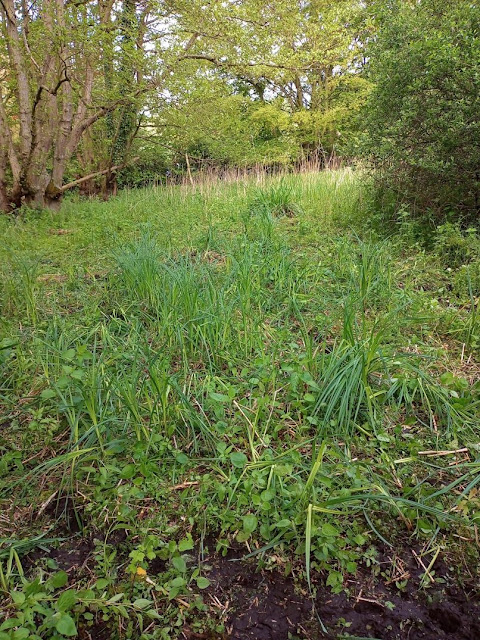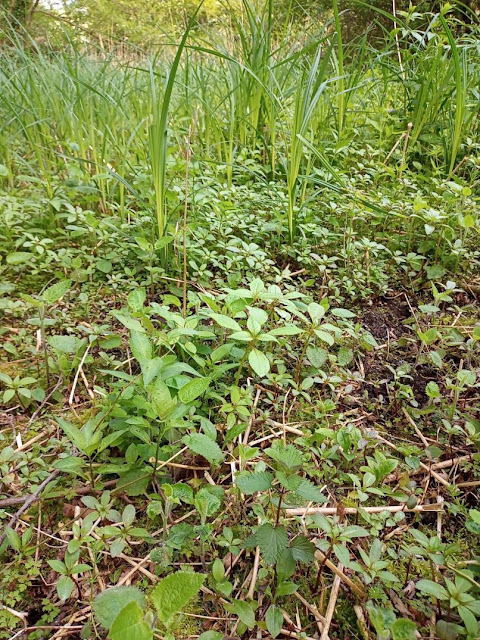“Don’t cast a clout until May is out” as the saying goes. If that refers to the May blossom, that’s well and truly out now; to me its perfume is the smell of Spring.
Happily, we seem to have good numbers of swallows in the
area, but so far as I can see swifts and house martins are in worryingly short
supply. Blackcaps and whitethroats are singing from almost every bush, but the
Common’s ‘signature species’ of reed buntings and warblers are not so evident.
My best bird of the spring, albeit only fleetingly, was a ring ouzel that
popped in on its way to its upland breeding grounds. It wasn’t reported on the
Common itself, but it was in a garden adjacent to it, and I had excellent views
of it on the recreation ground.
No doubt some clouts were cast on today’s working party to
keep the Common’s Himalayan Balsam in check, the weather being warm (despite a
nagging wind) and sunny. HB as it’s not particularly affectionately known is,
as its name implies, native to the lush lower slopes of the Himalayas. It’s in
Southrepps not because of our high elevation, but because some bright spark
thought it would make a nice garden plant, ignoring its propensity to spread
along watercourses the length and breadth of the land. It out-competes native
riverside vegetation, which is bad in itself, but when it dies off in the
winter it leaves denuded banks vulnerable to erosion, which is worse,
especially if you’re a water vole.
So it has to go, and when eagle-eyed team leader Margaret
saw that it had raised its undeniably pretty head, a balsam-bashing session was
hastily convened. Eight doughty volunteers turned up, suitably attired to ward
off stinging nettles and squishy ground. Your usual correspondent was not among
them, having come up with yet another tissue-paper thin excuse for absence, but
they were joined by our two latest volunteers, Sam and Gary. The following
update therefore comes courtesy of the said team leader:
“The area was in the trees at the bottom of area A nicely sheltered from the wind.
Our youthful new volunteer was disappointed by how small the target plants were, anything from 4 cms high to 30 cms; we have promised him taller ones as the season progresses. There were however plenty of them.
Due to the extreme bending involved we only worked for an hour and pulled up literally thousands of the wee beggars.
We seek it here...
... We seek it there
The final haul
Nothing eventful happened (no-one falling in the mud, chased by wasps or anything very exciting), so instead here are photos of some of the plants out at the moment.
Orchid
Ragged robin here
Sedge
We are going to hold another HB party in two weeks’ time: same time, same place.
And finally, here is the recently cut Area B, already
growing back vigorously.”
Here is Margaret’s message of thanks:
Good afternoon.
A huge thank you to the 8 people who turned up at short
notice for our first Himalayan Balsam pull of the season. I hope none of you have suffered from being
bent double for an hour. We were trying to get as many seedlings as possible.
We will be repeating the exercise in two weeks time when I am sure the height
and number of plants will also have doubled!.
Thanks again
Margaret (for the team leaders)
I’ve read a few great nature-related books lately. George Monbiot’s Regenesis: feeding the world without devouring the planet is extremely thoroughly researched, as one would expect from this highly respected author. The first part of the book sets out the many catastrophic problems caused worldwide by intensive agricultural practices and the food production industry. Once those have been set out, the remainder of the book explores some of the more optimistic developments which might, just might if adopted around the globe, save us from some of the worst effects of global heating and biodiversity depletion. It’s an important book, and well worth the read, even if it’s a tough one.
The Flow: rivers, water and wildness by Amy-Jane Beer
is a beautifully written account of her explorations in the last couple of
years of many of Britain's rivers; some in better condition than others. Beer was previously a very keen white water
kayaker, but after the tragic death of a close friend she fell out of love with
the activity. However, she still looks at rivers with a practised eye to assess
their suitability for the sport. The book was published last year, but now that
some politicians have woken up to the dire condition of our seas and
rivers, it’s very topical.
The Meaning of Geese by North Norfolk resident and
Norfolk Wildlife Trust Wildlife Ambassador Nick Acheson is another delight.
This is his first book, published this year, in which he recounts his travels
by bicycle during the Covid lockdowns along the North Norfolk coast in search
of the geese he has loved his entire life. It's not just for bird lovers - he
describes the coastline he knows so well perfectly. And there’s a connection
with our little group: soon after NWT took on the management of Southrepps
Commons, Nick visited us with a film crew to include us in a film as part of
the ‘Wildlife in Common’ project: it can still be seen at https://www.norfolkwildlifetrust.org.uk/news-and-articles/films/all-films/wildlife-in-common-people-and-wildlife
or on Youtube at Wildlife
in Common: people and wildlife - YouTube











